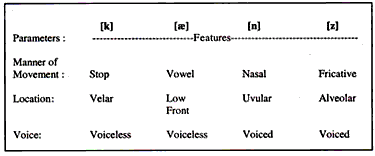Two Notation Systems for Signed Languages: Stokoe Notation & Sutton SignWriting Joe Martin Western Washington University Martinj4@cc.wwu.edu |
||||||||||||
|
DESCRIBING LANGUAGE continued... For really detailed study linguists use a phonetic feature matrix (see note A). Features in this sense are the specific settings of the parameters. For example, generally the vocal cords can either be vibrating or not, so there are two possible settings. We say Voicing is a parameter, and it has two possible features, voiced and voiceless.
In most languages the parameter of tongue position includes about six locations in the mouth, so there are six possible features to choose from. To describe a segment, a feature matrix lists all the parameters, with the specific feature for each one described in anatomical terms as in Figure 3. In actual use it gets much more complicated, but all it really does is give the same information as the schematics. It is really impossible to "read" feature notation (Kim 150).
A simpler way to describe speech segments is with an alphabet. For this, a set of symbols is chosen and used as names for the segments as we did above with [u] and [o]. Along the top of Figure 3 we can see the names given to each segment by the International Phonetic Alphabet. Our own Roman alphabet is shown in Figure 1. So these are three ways of describing segments of language: alphabets, schematics, and feature notation. All three of these do the same job of describing particular segments of language. |
||||||||||||
|
|
